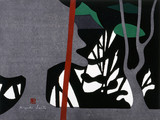Saito experienced a considerable vogue in the West in the 1950s and 60s, combining an identifiably Oriental aesthetic with clear European influences. This popularity, which in the 1970s began to decline, has obscured the significance of his work taken as a whole; this lies in his ability to use the tactile, grainy qualities of woodblock with complete conviction for non-abstract subjects. A man of some individuality, he was born in Fukushima Prefecture and moved as a child to the northern island of Hokkaido. He moved to Tokyo in 1932. He began studying oil-painting at the private Hongo Painting Institute. In Tokyo Petit records that he was surprised to find the woodblock prints he had been experimenting with were a well-established form which could be produced in editions and could use more than one block. In 1937 he joined Ono Tadashige's Zokei Hanga Kyokai (Plastic Print Association). Saito's history is essentially that of the gradual self-education of a natural artist into at one stage a teacher of printmaking at Ann Arbor, Michigan (1956-7). This process involved some loss of spontaneity which affected his work after that period.
Saito was self-taught but associated with other artists of the 'Sosaku Hanga' movement, had a print accepted for the Kokuga-kai exhibition in 1937, and began showing with the Japanese Print Association in 1942. Munch and Onchi were early influences. He contributed to the three nostalgic albums published by Fugaku Shuppansha in 1945-6 as an expression of the good side of Japanese art led by the 'Sosaku Hanga' movement. In 1948 his work came to the attention of American connoisseurs at the Salon Printemps exhibition which had been organised to help print artists in the post-war difficulties. In 1951 he surprised the Japanese art world by taking the first prize (together with the etcher Komai Tetsuro) for a Japanese work at the first São Paolo Biennale. It was this event that first brought the modern school of Japanese prints to prominence and was rapidly followed by other successes. Saito was featured in Statler's 'Modern Japanese Prints: An Art Reborn'(1956) by which time he was already popular in the West. His early prints were of winter scenes in his native Aizu, but he moved on to figure subjects in a rather European style, and then on to Buddhist subjects and the buildings and culture of Kyoto, in which the influence of Mondrian is very strong, as well as studies of ancient pottery, of cats and of flowers. His work is varied and prolific and subject to many changes in technique.
Bibliography
Smith, Lawrence, 'Modern Japanese Prints 1912-1989: Woodblocks and Stencils', BMP, London, 1994, pp. 33-4 and nos 93-4.
Statler, Oliver, 'Modern Japanese Prints: An Art Reborn', Turtle, Rutland, Vermont, and Tokyo, 1956, pp. 53-61.
Merritt, Helen, 'Modern Japanese Woodblock Prints: The Early Years', University of Hawaii Press, Honolulu, 1990, pp. 243-7.
Petit, Gaston, '44 Modern Japanese Print Artists', II, Kodansha International, Tokyo, 1973, pp. 104-5.
Hasegawa, Kimiyuki (ed.), 'Gendai hanga zukan', Keisuisha, Tokyo, 1977, pp. 98-9.
'Hanga geijutsu', 12, Special feature on Saito Kiyoshi, Abe Publishing Co., Tokyo, 1976, pp. 61-72. - British Museum
Kiyoshi Saitō
43 records
Include records without images
About this artist










